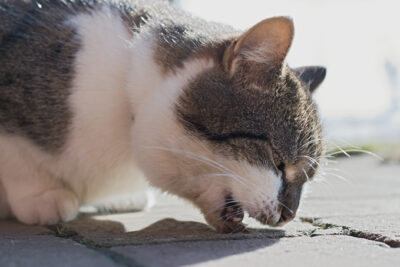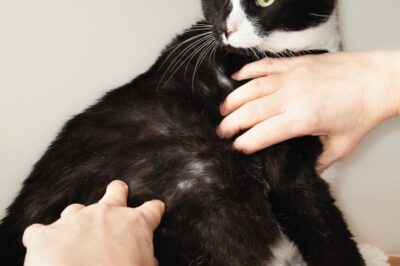Flea Allergy Dermatitis in Cats

Overview
All featured products are chosen at the discretion of the GreatPetCare editorial team and do not reflect a direct endorsement by the author or reviewer.
Nobody likes the idea of bugs crawling in their hair, and many of us can still remember the maddening sensation of having lice as kids. So, when we hear that our cat has fleas, we can imagine the discomfort they feel from having the creepy crawlies in their fur. For some of our feline friends, cat flea bites lead to an extremely uncomfortable condition called flea allergy dermatitis.
Overall, flea allergy dermatitis is the most common skin disease of dogs and cats in most countries of the world. In areas known to have fleas, flea allergy dermatitis is the first thing your veterinarian wants to rule out when you bring in your itchy cat. This can be very frustrating for you as the pet parent, who may not even know your pet has fleas. It can take just one flea bite to cause flea allergy dermatitis.
What Is Flea Allergy Dermatitis in Cats?
Flea allergy dermatitis is more than the simple itchiness that your cat experiences from having fleas crawling around and biting them. Some cats are actually allergic to the flea’s saliva.
Not all cats are allergic to flea bites. In fact, most cats will experience only mild skin irritation as a response to fleas biting. Your typical cat may still have redness and hair loss from overgrooming, but it won’t be as severe as you’d see with flea allergy dermatitis. On the other hand, cats who are allergic to flea saliva can have a full-blown allergic response to just one flea bite! Around 2 percent of cats are allergic to flea saliva, with no specific breed predispositions known at this time.
Causes of Flea Allergies in Cats

Flea allergies in cats only happen from flea bites. The mere presence of a flea won’t cause a reaction, but it would be very rare for a flea to land on your cat and NOT try to take a bite. The warm environment of a cat’s fur is perfect for a flea to find their next meal. Fleas bite your cat to feed on blood, which is how your cat gets exposed to the flea’s saliva.
When a flea bites them, the cat’s body has an overreaction to specific proteins in the flea’s saliva, and this exaggerated response manifests as flea allergy dermatitis. Repeated exposure to flea saliva causes the cat to develop a hypersensitivity reaction. In most cases, this hypersensitivity reaction manifests as flea allergy dermatitis.
Like how allergies can worsen in people with repeated exposure, your cat’s signs may worsen with each reinfestation.
Symptoms of Flea Allergy Dermatitis in Cats
Most signs of flea allergies in cats are related to the condition of your cat’s skin. Some pet parents may refer to this as a flea rash. The typical signs of flea allergy dermatitis in cats include:
- Itchy skin (pruritus), most notably on the rump, head, and neck
- Redness or pink tinge to skin due to inflammation (erythema)
- Symmetrical hair loss, usually affecting the sides, rump, tail-base, and thighs
- Crusts or small bumps (papules), often around the neck and lower back
- Vomiting hairballs from overgrooming
- Scratch marks from itching
- Tapeworms (your cat can get tapeworms from swallowing fleas)
While live fleas and flea dirt can certainly be present with a flea allergy in cats, keep in mind that cats are fastidious groomers. It’s common for cat parents not to even know that their flea-allergic cat has fleas!
In some cases, a condition known as eosinophilic granuloma complex (ECG) may also occur. With ECG, your cat may develop lip ulcers, raised plaques on the skin, or granulomas of the skin.
Diagnosing a Flea Allergy in Cats

In most cases, your veterinarian will be able to diagnose flea allergy dermatitis in your cat with a physical exam. If your pet has the characteristic skin allergy signs and the veterinarian finds a flea or flea dirt, a flea allergy will be their presumptive diagnosis.
The veterinarian may use a flea comb to check for fleas or dirt. Flea dirt is the excrement of fleas, which turns red or a rusty color when wetted because it’s digested blood. If the veterinarian finds brown or black specks on your cat, they may wet the specks with a paper towel to see if they turn this characteristic rusty red color.
Typically, the veterinarian won’t need to run blood work. However, if your cat is very young or has a very high number of fleas on them, the fleas can actually feed on your cat enough to cause anemia. If the veterinarian suspects anemia based on their physical examination, the veterinarian may at least recommend checking to ensure your cat isn’t anemic from blood loss. Signs of anemia would include pale gums, weakness, and lethargy.
In most cases, the veterinarian will recommend treating your pet intensively for flea allergy dermatitis for at least six weeks. If the fleas are gone after this time but the itchiness and red skin continues, then your veterinarian may recommend food elimination diets or skin testing for allergies. While flea allergies are the top cause of itchy skin conditions in areas with fleas, environmental allergies and food allergies can also cause skin inflammation in cats.
Treating Flea Allergy Dermatitis in Cats

Luckily, there’s a solution to flea allergy dermatitis in cats. It starts with ridding your cat of those pesky fleas!
One option is to use a fast-acting oral medication like nitenpyram that starts killing adult fleas on your pet within 30 minutes.
However, getting rid of adult fleas on your cat is only half the battle. While 5 percent of the fleas in an infestation are adult fleas which can jump onto your pet and bite them, the remaining 95 percent are still in earlier life stages within the environment—eggs, larvae, and pupae. You must disrupt the life cycle to eliminate the risk of re-infestation
To protect cats from fleas and ongoing infestations, veterinarians recommend year-round flea prevention that kills adult fleas and interrupts their life cycle.
Luckily, there are plenty of flea preventatives available, many of which also help protect against other parasites, such as ticks, heartworms, or intestinal worms.
Your vet will recommend a treatment plan that best fits your cat’s parasite prevention needs. Options may include:
Oral flea medications – These meds are designed to be given to your pet once a month. They work from the inside out, delivering fast-acting flea-killing power that protects your pet all month long.
Oral flea medications are effective against flea infestations because they kill adult fleas that bite your pet, preventing them from laying any more eggs. Plus, as long as you administer the medicine every month, they also kill any newly-hatched fleas that bite your pet.
Vet-recommended oral flea medication include Credelio Cat, which comes in a tasty, vanilla-flavored chewable tablet (that protects against a species of tick, too) and Comfortis chewable tablets.


Topical flea treatments – These meds are applied directly to your cat’s skin, where they spread throughout the skin and coat, killing adult fleas on contact. Some also contain ingredients that prevent eggs and larva from developing into adults.
Like oral flea meds, topicals are designed to be administered regularly (every one to three months, depending on the product), and many also provide protection against other parasites.
Topical options vets often recommend include NexGardCOMBO, Revolution Plus, and Bravecto.



Other options to fight fleas on your pet and in your household include flea collars, flea shampoos, and flea sprays. But always consult your vet to ensure the product is safe.
Permethrin is in many flea treatments for dogs, but this medication is very dangerous for cats. This ingredient can cause vomiting, diarrhea, tremors, seizures, and death in cats. Ensure the product you use is labeled for cats! Do not use any product that lists permethrin as an ingredient on your cat.
In addition to treating the flea infestation, cats with FAD may need treatment for secondary skin infections resulting from skin irritation and scratching.
If this is the case for your cat, your veterinarian will prescribe antibiotics to help treat the infection. If your pet’s skin allergy is moderate to severe, the veterinarian may also give a steroid injection or prescribe short-term steroids like prednisolone to give your pet more immediate relief. Steroids help reduce inflammation and can slow the immune system’s overreaction to the flea’s saliva.
Most cats continue treatment at home. Hospitalization is not typically necessary, but very young, sick, or anemic animals may need to stay in the hospital for monitoring or, rarely, a blood transfusion.
Fighting fleas on the homefront
When it comes to managing the fleas in the environment, there are several steps you can take:
- Use products on your pet that interrupt the flea life cycle (at the recommended intervals) to prevent re-infestation.
- Treat all in-contact animals with flea and tick prevention! This is a MUST.
- Wash your pet’s bedding, blankets, and soft toys on high heat. Repeat several times per week.
- Apply a spray that is designed to kill the flea (including younger life stages) to the surfaces in your home. You should apply the spray until the surface is damp to the touch.
- Vacuum the carpets and upholstery daily while managing the infestation. Throw out the contents of the vacuum bag or canister in a tightly sealed plastic bag after each vacuuming session.
- Consider outdoor exposures. It’s very difficult to control exposure if your cat goes outside, so consider keeping severely allergic cats indoors. If you think your outdoor area needs treatment, consider consulting a pest specialist.
If you can’t get in soon to see your veterinarian, it’s a good idea to bathe your cat if they’ll tolerate it. You can use a cat-friendly shampoo, but regular dish soap such as Dawn is safe in a pinch. Whether your cat allows the bath or not, you can use a flea comb to help remove more fleas. Some flea and tick preventatives are available without a prescription and can help you start getting the infestation under control.
How to Prevent Flea Allergy Dermatitis in Cats

Remember that it can only take one flea bite to keep your flea-allergic cat itchy! While the task may seem daunting, prevention is key to keeping your pet healthy and happy.
Keep your cat and any in-contact pets on monthly flea control year-round. Fleas can continue to live indoors during the winter months. While the warmer months of the year have typically been considered flea season (year-round in some southern and coastal areas, spring to fall in northern areas), flea season has been expanding to involve more months of the year. Year-round prevention is the best way to keep your pet from experiencing an allergic reaction.
Wild animals, community cats, stray animals, and pets you share a fence-line with can all be flea reservoirs. Keeping your cat indoors reduces their potential exposure to new flea infestations.
Remember that a large part of a flea infestation occurs in the environment. Regular vacuuming can help catch fleas who may have hitched a ride on your dog during their afternoon walk.
If you are struggling to control a flea infestation, consider speaking with your veterinarian or a pest specialist. Once you get rid of a flea infestation, prevention of future infestations becomes easier. With patience, you can help your flea-allergic cat get back to their usual frisky self.









